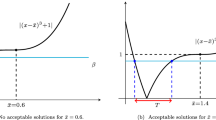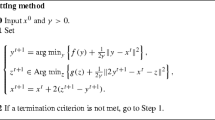Abstract
We show that Dykstra’s splitting for projecting onto the intersection of convex sets can be extended to minimize the sum of convex functions and a regularizing quadratic function. We give conditions for which convergence to the primal minimizer holds so that more than one convex function can be minimized at a time, the convex functions are not necessarily sampled in a cyclic manner, and the SHQP strategy for problems involving the intersection of more than one convex set can be applied. When the sum does not involve the regularizing quadratic function, we discuss an approximate proximal point method combined with Dykstra’s splitting to minimize this sum.
Similar content being viewed by others
References
Dykstra, R.: An algorithm for restricted least-squares regression. J. Am. Stat. Assoc. 78, 837–842 (1983)
Boyle, J., Dykstra, R.: A method for finding projections onto the intersection of convex sets in Hilbert spaces. In: Dykstra, R., Robertson, T., Wright, F.T. (eds.) Advances in Order Restricted Statistical Inference. Lecture notes in Statistics, pp. 28–47. Springer, New York (1985)
Han, S.: A successive projection method. Math. Program. 40, 1–14 (1988)
Gaffke, N., Mathar, R.: A cyclic projection algorithm via duality. Metrika 36, 29–54 (1989)
Iusem, A., Pierro, A.D.: On the convergence of Han’s method of convex programming with quadratic objective. Math. Program. 52, 265–284 (1991)
Pierra, G.: Decomposition through formalization in a product space. Math. Program. 28, 96–115 (1984)
Hundal, H., Deutsch, F.: Two generalizations of Dykstra’s cyclic projections algorithm. Math. Program. 77, 335–355 (1997)
Pang, C.: The supporting halfspace—quadratic programming strategy for the dual of the best approximation problem. SIAM J. Optim. 26(4), 2591–2619 (2016)
Deutsch, F.: Accelerating the convergence of the method of alternating projections via a line search: a brief survey. In: Butnariu, D., Censor, Y., Reich, S. (eds.) Inherently Parallel Algorithms in Feasibility and Optimization and Their Applications, pp. 203–217. Elsevier, Amsterdam (2001)
Deutsch, F.: Best Approximation in Inner Product Spaces. CMS Books in Mathematics. Springer, Berlin (2001)
Bauschke, H., Combettes, P.: Convex Analysis and Monotone Operator Theory in Hilbert Spaces. Springer, Berlin (2011)
Escalante, R., Raydan, M.: Alternating Projection Methods. SIAM, Philadelphia, PA (2011)
Beck, A., Tetruashvili, L.: On the convergence of block coordinate descent type methods. SIAM J. Optim. 23(4), 2037–2060 (2013)
Beck, A.: On the convergence of alternating minimization for convex programming with applications to iteratively reweighted least squares and decomposition schemes. SIAM J. Optim. 25(1), 185–209 (2015)
Tseng, P., Yun, S.: A coordinate gradient descent method for nonsmooth separable minimization. Math. Program. Ser. B 117(117), 387–423 (2009)
Tseng, P., Yun, S.: Block-coordinate gradient descent method for linearly constrained nonsmooth separable optimization. J. Optim. Theory Appl. 140, 513–535 (2009)
Wright, S.: Coordinate descent algorithms. Math. Program. 151, 3–34 (2015)
Hong, M., Wang, X., Razaviyayn, M., Luo, Z.: Iteration complexity analysis of block coordinate descent methods. Math. Program. 163, 85–114 (2017)
Martinet, B.: Régularisation d’inéquations variationnelles par approximations successives. Rev. Française Informat. Rech. Opér. 4, 154–158 (1970)
Rockafellar, R.: Monotone operators and the proximal point algorithm. SIAM J. Control Optim. 14, 877–898 (1976)
Han, S.: A decomposition method and its application to convex programming. Math. Oper. Res. 14, 237–248 (1989)
Bauschke, H., Combettes, P.: A Dykstra-like algorithm for two monotone operators. Pac. J. Optim. 4, 383–391 (2008)
Tseng, P.: Dual coordinate ascent methods for non-strictly convex minimization. Math. Program. 59, 231–247 (1993)
Combettes, P., Dũng, D., Vũ, B.: Proximity for sums of composite functions. J. Math. Anal. Appl. 380(2), 680–688 (2011)
Combettes, P., Dũng, D., Vũ, B.: Dualization of signal recovery problems. Set-Valued Var. Anal. 18, 373–404 (2010)
Abboud, F., Chouzenoux, E., Pesquet, J.C., Chenot, J.H., Laborelli, L.: Dual block-coordinate forward–backward algorithm with application to deconvolution and deinterlacing of video sequences. J. Math. Imaging Vis. 59(3), 415–431 (2017)
Nedić, A.: Random algorithms for convex minimization problems. Math. Program. Ser. B 225, 225–253 (2011)
Nesterov, Y.: Introductory Lectures on Convex Optimization. Kluwer, London (2004)
Beck, A., Teboulle, M.: A fast iterative shrinkage-thresholding algorithm for linear inverse problems. SIAM J. Imaging Sci. 2(1), 183–202 (2009)
Tseng, P.: On accelerated proximal gradient methods for convex-concave optimization (2008)
Bauschke, H., Borwein, J.: On projection algorithms for solving convex feasibility problems. SIAM Rev. 38, 367–426 (1996)
Censor, Y., Chen, W., Combettes, P.L., Davidi, R., Herman, G.: On the effectiveness of projection methods for convex feasibility problems with linear inequality constraints. Comput. Optim. Appl. 51, 1065–1088 (2012)
Neto, E.H., Pierro, A.D.: Incremental subgradients for constrained convex optimization: a unified framework and new methods. SIAM J. Optim. 20, 1547–1572 (2009)
Ram, S., Nedić, A., Veeravalli, V.: Incremental stochastic subgradient algorithms for convex optimization. SIAM J. Optim. 20, 691–717 (2009)
Censor, Y., Davidi, R., Herman, G.: Perturbation resilience and superiorization of iterative algorithms. Inverse Probl. 26(6), 065008 (2010)
Censor, Y., Davidi, R., Herman, G., Schulte, R., Tetruashvili, L.: Projected subgradient minimization versus superiorization. J. Optim. Theory Appl. 160, 730–747 (2014)
Bauschke, H., Borwein, J., Li, W.: Strong conical hull intersection property, bounded linear regularity, Jameson’s property (G), and error bounds in convex optimization. Math. Program., Ser. A 86(1), 135–160 (1999)
Burke, J., Deng, S.: Weak sharp minima revisited. II. Application to linear regularity and error bounds. Math. Program., Ser. B 104(2–3), 235–261 (2005)
Ng, K., Yang, W.: Regularities and their relations to error bounds. Math. Program., Ser. A 99, 521–538 (2004)
Kruger, A.: About regularity of collections of sets. Set-Valued Anal. 14, 187–206 (2006)
Boyd, S., Parikh, N., Chu, E., Peleato, B., Eckstein, J.: Distributed optimization and statistical learning via the alternating direction method of multipliers. Found. Trends Mach. Learn. 3(1), 1–122 (2010)
Combettes, P., Pesquet, J.C.: Proximal splitting methods in signal processing. In: Bauschke, H., Burachik, R., Combettes, P., Elser, V., Luke, D., Wolkowicz, H. (eds.) Fixed-Point Algorithms for Inverse Problems in Science and Engineering, pp. 185–212. Springer, New York, NY (2011)
Pang, C.H.J.: Distributed deterministic asynchronous algorithms in time-varying graphs through Dykstra splitting. SIAM J. Optim. 29(1), 484–510 (2018)
Acknowledgements
We acknowledge Grant R-146-000-214-112 from the Faculty of Science, National University of Singapore. We gratefully acknowledge discussions with Ting-Kei Pong on Dykstra’s splitting which led to this paper. We also thank the two anonymous referees and the editorial staff.
Author information
Authors and Affiliations
Corresponding author
Additional information
Communicated by Panos M. Pardalos.
Publisher's Note
Springer Nature remains neutral with regard to jurisdictional claims in published maps and institutional affiliations.
Rights and permissions
About this article
Cite this article
Pang, C.H.J. Dykstra’s Splitting and an Approximate Proximal Point Algorithm for Minimizing the Sum of Convex Functions. J Optim Theory Appl 182, 1019–1049 (2019). https://doi.org/10.1007/s10957-019-01512-z
Received:
Accepted:
Published:
Issue Date:
DOI: https://doi.org/10.1007/s10957-019-01512-z




